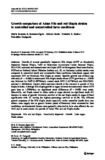Growth comparison of Asian Nile and red tilapia strains in controlled and uncontrolled farm conditions
Share
Abstract
Growth of several genetically improved Nile tilapia (GIFT or Genetically Improved Farmed Tilapia, FaST or Freshwater Aquaculture Center Selected Tilapia, SEAFDEC-selected) and domesticated red tilapia (BFS or Binangonan Freshwater Station, NIFI-red or National Inland Fisheries Institute red, HL or Hacienda Luisita) stocks were compared in controlled (tank) and uncontrolled farm conditions (lake-based cages) with unselected NIFI or Chitralada Nile tilapia as control. Specific growth rate differed significantly (P = 0.009) in tank-reared Nile tilapia stocks where GIFT grew best at 1.358%/day followed by FaST (1.307%/day), control stock NIFI (1.257%/day) and SEAFDEC-selected (1.202%/day). Genetic effect explained 84.4% of the variance in growth of Nile tilapia in tanks. Although Nile tilapia growth in cages followed the same trend where GIFT grew best at 1.570%/day, no significant stock differences (P = 0.479) were noted. Meanwhile, red tilapia reared in either tanks or cages showed no significant stock differences in terms of growth. However, survival of the red tilapia stocks in cages differed significantly with HL having the highest percentage survival at 93.3%. The different growth responses of the Nile tilapia stocks especially under controlled (tank) farm conditions were largely due to genetic factors (stock differences).Under uncontrolled farm conditions, environmental factors were generally observed to have also affected the survival and to some extent, the growth of Asian Nile and red tilapia stocks.
Suggested Citation
Romana-Eguia, M. R. R., Ikeda, M., Basiao, Z. U., & Taniguchi, N. (2010). Growth comparison of Asian Nile and red tilapia strains in controlled and uncontrolled farm conditions. Aquaculture International , 18(6), 1205-1221. https://doi.org/10.1007/s10499-010-9334-7
Subject
Collections
- AQD Journal Articles [1249]


